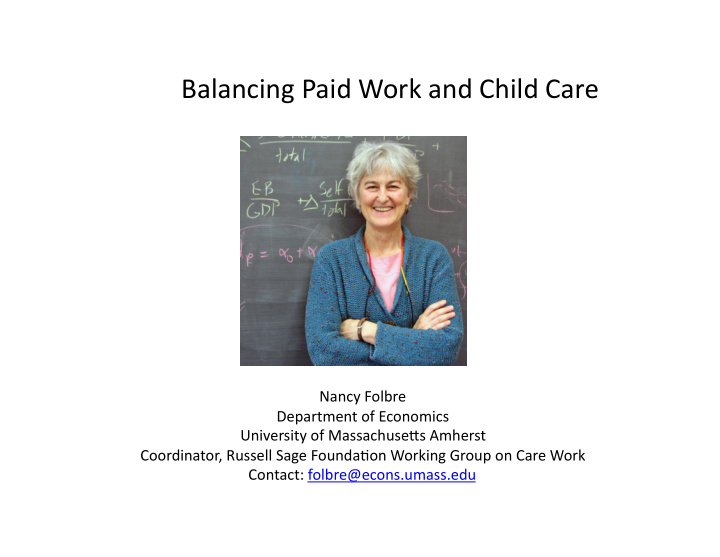



Balancing ¡Paid ¡Work ¡and ¡Child ¡Care ¡ ¡ Nancy ¡Folbre ¡ Department ¡of ¡Economics ¡ University ¡of ¡MassachuseAs ¡Amherst ¡ Coordinator, ¡Russell ¡Sage ¡FoundaFon ¡Working ¡Group ¡on ¡Care ¡Work ¡ Contact: ¡folbre@econs.umass.edu ¡ ¡ ¡
What ¡does ¡“balance” ¡mean? ¡ ¡ • Tradeoffs ¡between ¡paid ¡employment ¡and ¡child ¡care ¡ • InternaFonal ¡comparisons ¡ • ¡Recent ¡trends ¡in ¡U.S. ¡ ¡ • Policy/research ¡issues ¡ ¡ •
Defining ¡Balance ¡ No ¡single ¡formula—desire ¡to ¡help ¡parents ¡minimize ¡conflicts ¡or ¡negaFve ¡ ¡ trade-‑offs ¡between ¡paid ¡work ¡and ¡childcare. ¡ ¡ Need ¡to ¡provide ¡flexibility ¡for ¡caregivers ¡during ¡the ¡day, ¡week, ¡and ¡lifecycle ¡in ¡order ¡to ¡ ¡ promote ¡high ¡quality ¡care ¡and ¡reduce ¡economic ¡penalFes ¡on ¡care ¡givers. ¡
Factors ¡Relevant ¡to ¡Balance ¡ ¡ ¡ Ability ¡to ¡take ¡Fme ¡out ¡of ¡paid ¡employment • —family ¡leave ¡and ¡sick ¡leave. ¡ Flexible ¡work ¡hour ¡scheduling ¡with ¡ • employee ¡input. ¡ Freedom ¡from ¡“family ¡responsibility ¡ • discriminaFon.” ¡ ¡ OpportuniFes ¡for ¡part-‑Fme ¡work ¡that ¡ • include ¡job ¡ladders ¡and ¡benefits. ¡ Availability ¡and ¡affordability ¡of ¡child ¡care, ¡ • a\er-‑school, ¡and ¡summer ¡programs. ¡ Willingness ¡and ¡ability ¡of ¡fathers ¡to ¡help ¡ • provide ¡care. ¡ ¡
US ¡ ¡Workers ¡Spend ¡Excep;onally ¡Long ¡Hours ¡in ¡Paid ¡Work ¡ ¡ ¡ ¡ ¡ Figures ¡for ¡2005, ¡approximately. ¡ ¡ In ¡European ¡Union, ¡but ¡not ¡the ¡U.S., ¡ ¡part-‑Fme ¡workers ¡are ¡guaranteed ¡pay ¡ ¡ and ¡benefit ¡parity. ¡ Source: ¡Janet ¡Gornick, ¡Luxembourg ¡Income ¡Study, ¡CUNY ¡
Most ¡Other ¡Affluent ¡Countries ¡Guarantee ¡Paid ¡Family ¡Leave ¡ (early ¡2000s) ¡ ¡ Paid Family Leave Example of Leave for Mothers: Fully Paid Weeks Granted, Following Birth or Adoption includes: national social insurance programs, earnings-related benefits 42 42 37 29 16 16 14 12 0 Source: ¡Janet ¡Gornick, ¡Luxembourg ¡Income ¡Study, ¡CUNY ¡
Most ¡ ¡Other ¡Affluent ¡Countries ¡Provide ¡More ¡Support ¡for ¡Child ¡Care ¡ (early ¡2000s) ¡ ¡ Source: ¡Janet ¡Gornick, ¡Luxembourg ¡Income ¡Study, ¡CUNY ¡
Educated ¡Women ¡in ¡the ¡U.S. ¡ ¡ ¡Have ¡Increased ¡ ¡Their ¡Access ¡ ¡to ¡Private ¡Benefits ¡ Changes ¡Over ¡Time ¡ ¡in ¡Mothers' ¡Access ¡to ¡Paid ¡ Leave ¡by ¡Educa;onal ¡Level ¡ ¡ ¡ (maternity ¡leave, ¡sick ¡leave, ¡or ¡vaca;on ¡leave ¡at ¡first ¡birth) ¡ ¡ 66% ¡ 59% ¡ 27% ¡ 18% ¡ 18% ¡ 18% ¡ ¡1971-‑1975 ¡ 1981-‑1985 ¡ 2006-‑2008 ¡ Women ¡Lacking ¡a ¡High ¡School ¡Degree ¡ Women ¡with ¡a ¡Bachelor's ¡Degree ¡ Source: ¡Census ¡Bureau, ¡Maternity ¡Leave ¡and ¡Employment ¡PaAerns ¡of ¡First-‑Time ¡Mothers: ¡1961-‑2008 ¡
Child ¡Care ¡Arrangements ¡of ¡Employed ¡Mothers ¡in ¡2010 ¡ About ¡30 ¡percent ¡of ¡preschoolers ¡ were ¡cared ¡for ¡by ¡grandparents, ¡29 ¡ percent ¡by ¡fathers, ¡and ¡12 ¡percent ¡ by ¡siblings ¡or ¡other ¡relaFves. ¡ One-‑third ¡of ¡employed ¡mothers ¡ reported ¡that ¡they ¡paid ¡for ¡child ¡ care ¡for ¡at ¡least ¡one ¡of ¡their ¡ children. ¡ ¡ Families ¡in ¡poverty ¡who ¡paid ¡for ¡ care ¡spent ¡ ¡40 ¡percent ¡of ¡their ¡ Thanks ¡to ¡ ¡Allan ¡ChaAo ¡on ¡Flickr.com ¡for ¡his ¡CreaFve ¡Commons ¡licensing ¡of ¡ monthly ¡income ¡on ¡child ¡care, ¡ this ¡image. ¡ ¡ compared ¡with ¡7 ¡per ¡cent ¡among ¡ other ¡families. ¡ ¡ Source: ¡Who's ¡Minding ¡the ¡Kids? ¡ ¡Child ¡Care ¡Arrangements: ¡Spring ¡2010 ¡ hAp://www.census.gov/hhes/childcare/data/sipp/2010/tables.html ¡
More ¡ ¡Married ¡Fathers ¡ ¡Now ¡Provide ¡Regular ¡Child ¡Care ¡ Fathers ¡with ¡a ¡Wife ¡in ¡Paid ¡ Workforce ¡Providing ¡Regular ¡ Child ¡Care ¡ ¡ 32% ¡ 26% ¡ Thanks ¡to ¡Rebecca ¡Trynes ¡on ¡Flickr.com ¡for ¡her ¡ 2002 ¡ 2010 ¡ CreaFve ¡Commons ¡licensing ¡of ¡this ¡image. ¡ ¡ Source: ¡Who's ¡Minding ¡the ¡Kids? ¡ ¡Child ¡Care ¡Arrangements: ¡Spring ¡2010 ¡ hAp://www.census.gov/hhes/childcare/data/sipp/2010/tables.html ¡
In ¡Sum ¡ ¡ ¡College ¡-‑educated ¡, ¡married ¡women ¡in ¡the ¡U.S. ¡have ¡made ¡small ¡but ¡important ¡gains ¡ ¡ in ¡their ¡ability ¡to ¡balance ¡paid ¡work ¡with ¡child ¡care. ¡ ¡Less ¡educated, ¡unmarried ¡mothers ¡have ¡not ¡made ¡ ¡significant ¡gains ¡and ¡seem ¡to ¡ ¡ be ¡paying ¡more ¡for ¡child ¡care ¡than ¡in ¡the ¡past. ¡ ¡ ¡More ¡universal ¡policies ¡such ¡as ¡federally ¡mandated ¡paid ¡leaves ¡for ¡family ¡care, ¡sick ¡ leaves, ¡and ¡pre-‑K ¡educaFon ¡would ¡reduce ¡inequality. ¡ ¡ ¡ ¡Some ¡such ¡policies ¡are ¡being ¡developed ¡on ¡the ¡state ¡level, ¡providing ¡opportunity ¡for ¡ analysis ¡of ¡costs ¡and ¡benefits. ¡ ¡
Recommend
More recommend